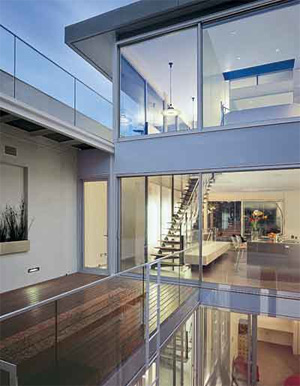Developers are often another story. As a rule, jobs with big-time developers remain elusive to most of the female architects interviewed. Deborah Berke, AIA, who has a New York office with 25 architects and designers, observes that the old-fashioned developer can still be dismissive, but then she doesn’t run into that sort too often. “The ones who call women are already open; they are a preselected group,” she notes. Julie Snow, FAIA, whose Minneapolis practice varies between 10 and 15 people, comments that some clients aren’t going to feel comfortable with a female. “On the other hand, we’ve gotten jobs because male clients want a female perspective—and not only about the design of the kitchen,” she says. Audrey Matlock, AIA, who has a 12-person office, AM Arch, in Manhattan, notes that if you don’t get a job, you are never quite sure whether gender was behind it. Right now she is designing a sports center and a large (30,000-square-foot) house in Kazakhstan—which she got through a referral from Skidmore, Owings & Merrill (SOM), a former employer.

![]() Female Firms, Male Values? Are women trying too much to emulate men's values, attitudes and approaches in order to run successful architecture firms? Respond now.
Female Firms, Male Values? Are women trying too much to emulate men's values, attitudes and approaches in order to run successful architecture firms? Respond now.
Ronnette Riley, FAIA, whose New York office opened in 1987 and numbers 14 architects and designers, has found working with developers difficult because they are “conservative and risk-averse. They want to work with people who look like them.” Yet Riley adds she met one developer who became a client because of a car she bought—a BMW 645 CI. “He stopped me and asked me about how the car ran,” says Riley, who, as a native Californian, could talk the guy talk. (She also met another client, a writer, over a similar chat about the car.) Alison Spear, AIA, who has a six-person office in Miami, Florida, loves working with developers—the more intense the better. She just finished her first 12-story condominium building, The Spear, for the developer of Aqua, Craig Robins. Spear, who provides interior design services as well as architectural ones, and used to be based in New York, says many clients like the one-stop-shopping approach.
The press
Publicity matters, architects know. But how do you get press when you are starting out? Sometimes it’s the nature of the work, sometimes the sort of client. When Spear lived in New York, she found she got a lot of press with her first job—designing a loft 20 years ago for Jay McInerney, whom she had met through a group of young people at the National Arts Club. Spear, who studied architecture at Cornell University, had decided to take a job as an architect for the interior designer Juan Pablo Molyneux, where she incidentally learned about antiques, color, and fabrics. “The architecture training at Cornell was very Corbusian, very white,” she says. “I thought a sconce was something you ate.” Now that she has been working on both sides of the design divide, however, she finds that too often the press assumes she is a decorator. “The image is hard to overcome, especially in the shelter magazines,” she says. Jennifer Luce, AIA, of San Diego, who has an interest in landscape and furniture design, as well as architecture, explains that not only her interests, but the fact that her firm, Luce et Studio, is 75 percent female causes people to assume the firm only does interiors. Having just won a Business Week/Architectural Record award for 2006 for her Nissan Design America building outside Detroit and a Nissan design studio in La Jolla, California [record, November 2006, page 90], should help Luce dispel this notion, but she says, “It’s hard, because I want to articulate every detail of the job.”
New York–based Annabelle Selldorf, AIA, seems to find little difficulty getting press, much of it stemming from her art-world clients, who commissioned galleries and artists’ lofts, plus the Neue Galerie Museum for German and Austrian Art in Manhattan. “I started alone in 1989 with a kitchen renovation,” she notes. But now Selldorf Architects numbers 33 people, and, as the interior architect for the Urban Glass House, a condominium project in Manhattan designed by Philip Johnson/Alan Ritchie, she is part of a major “branding” campaign. Lindy Roy, who founded her office, ROY, in 2000, and averages about 10 people, was selected in 2001 to design a temporary courtyard installation at P.S. 1 Contemporary Art Center in Long Island City, New York, as part of the MoMA/P.S.1 Young Architects program. “The press coverage had an amazing effect—it triggered attention from clients,” says Roy, a South African–born and Columbia-trained architect, who designed André Balasz’s Hotel QT, a former office building near Times Square, in 2005.
Winka Dubbeldam, who arrived in the New York from the Netherlands in the early 1990s to study at Columbia, previously had an office in Holland. She got jobs working in the high-profile offices of Steven Holl, Bernard Tschumi, and Peter Eisenman here, but her experience in Holland led her to decide to open her own office, Archi-tectonics, in 1994. Now her firm has 15 architects and designers. “I had no press until 1997,” she notes, adding, “I’m kind of shy.” Dubbeldam explains she left it to “luck, and my theory that you keep working slowly, teach, research, and take on jobs you believe in—the slow route.” Having a project in Millbrook, New York, included in the 1999 Museum of Modern Art exhibition The Un-Private House, however, didn’t hurt.
Not surprisingly, a number of women architects remark that Zaha Hadid gets all the attention from the press, even while they avow, “More power to her.” Of course the scale and dynamic inventiveness of Hadid’s recent built work—from museums to automobile plants—has helped, along with her larger-than-life persona. As Toshiko Mori, FAIA, who has a New York office of a dozen people while occupying the chair of architecture at Harvard’s Graduate School of Design, notes, “The press wants impact—people who produce an interesting narrative.” Mori points out, however, that Kazuyo Sejima (of SANAA) is also getting attention from the press, and “she’s the opposite of Zaha—very self-effacing and not gregarious.” Still, she notes, the media go for the exotic and the extreme in architectural design: “Some of us deal with ordinary, not glamorous issues.”
Getting publicity is important, but some women, such as Berke, contend that “good press does not specifically lead to new work––and this is not a gender issue. The press attention usually validates your work for your existing clients.” Nevertheless, Berke says that people tend to keep clips on an architect—for years. When Jerry Adler, was writing High Rise: How 1,000 Men and Women Worked Round the Clock for Five Years and Lost $200 Million Building a Skyscraper, published in 1993, he focused attention on Matlock, then a senior designer at SOM. She easily came across as one of High Rise’s liveliest characters: New York magazine even prominently displayed a photo of the blond-haired Matlock in a black leather jacket on a red Ducati motorcycle in its May 3, 1993, coverage of the book. By then, Matlock had opened her own storefront office in New York City’s Tribeca—where she and her team of 12 visibly demonstrate to passersby what an architect does.
Related to press coverage is the question of marketing—that is, going after work in a systematic way. Many of the women architects interviewed take a wait-for-the-phone-to-ring approach. Fougeron admits that she “tries to meet new people and have my clients introduce me to other clients.” She also argues that “women architects have to work twice as hard as men to get attention and prove themselves.” Margaret Helfand, FAIA, whose New York office, Helfand Architecture, numbers 10 architects and designers, maintains that marketing is “the most critical piece of daily experience, yet the toughest nut to crack for any architect.” Academic experts concur: Katherine Anthony, professor of architecture at the University of Illinois-Urbana Champaign and author of Designing for Diversity (2001), argues that “networking is all the more crucial to women who run their own architectural practice.”



Post a comment to this article
Report Abusive Comment